What Is Used in Art That Looks Like Bone
Custom Knife Handle Materials: Horn, Bone, Ivory, and Beat out
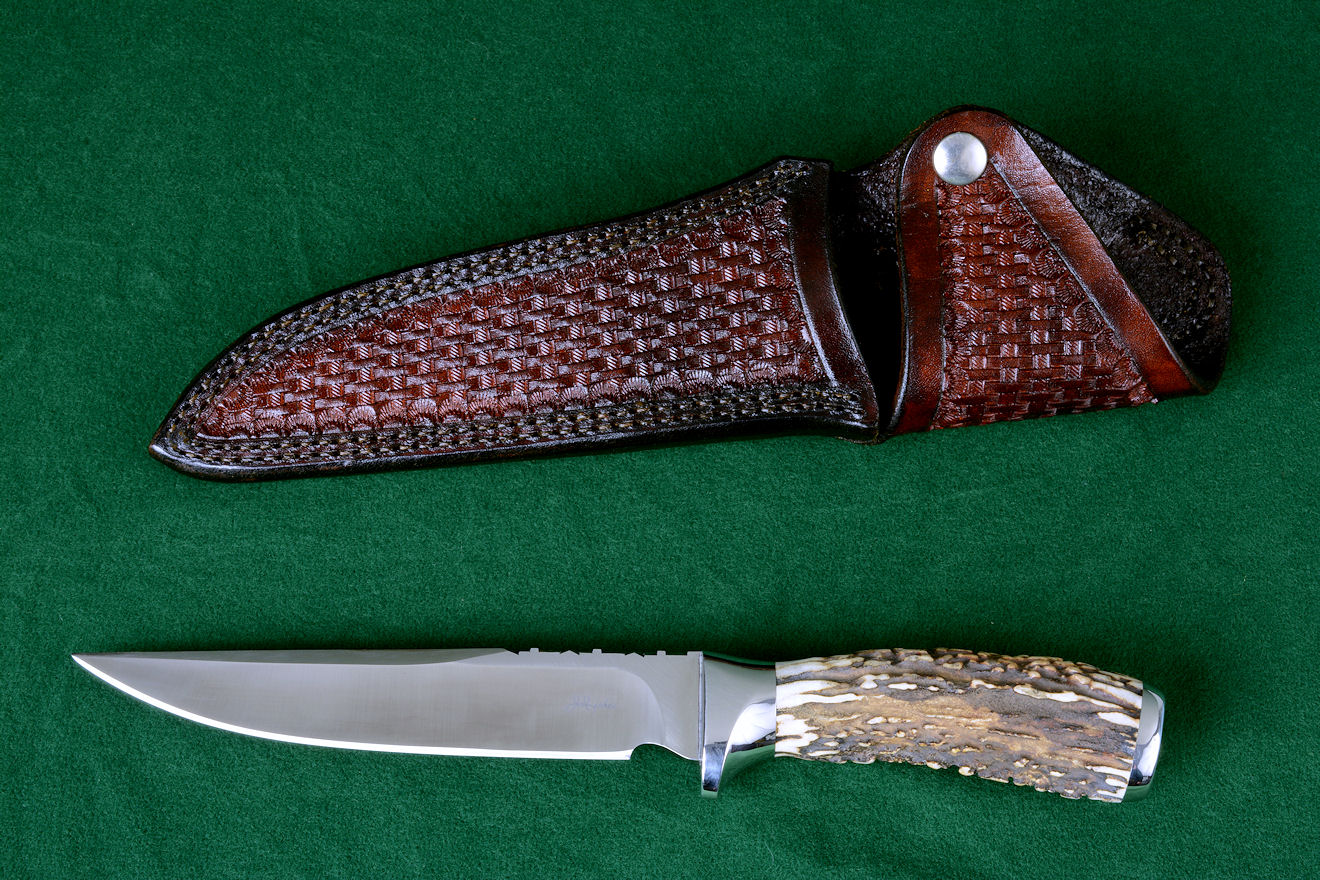
More about this "Yarden"
Horn, bone, trounce, and ivories used in modern custom and handmade knife handle and component construction offer visual interest, tactile security, or great beauty and value. This page is about these natural materials.
Notice! Every bit of July 6, 2016, at that place is a near-total ban on elephant ivory sales in the Us!
Please click on the items in the list below to jump downwardly the page to details of each item or species.
| Natural Creature Knife Handle Materials | ||||
| Antler | Horns | Ivories | Bone | Pearl, Shell, Coral |
| Deer Antler | Sheep Horn | Elephant Ivory | Animal Os | Female parent of Pearl |
| Elk Antler | Kudu | Mammoth Ivory, Mastodon Ivory | Jigged Bone | Gilt lipped Mother of Pearl |
| Sambar Stag | Springbok Horn | Walrus Tusk | Giraffe Bone | Tiger Coral |
| Stag (Scales) | Impala Horn | Fossil Walrus Tusk | Oosic | Abalone Trounce |
| Stag (Crowns) | Gazelle Horn | Wart Hog Tusk | Oosic, Fossil | Paua Shell |
| Caribou | Oryx | Hippopotamus Tusk | ||
| Special Treatments | Greatcoat Buffalo Horn | Elk Ivory | ||
| Ox Horn | Whale'south Tooth | |||
| Moo-cow Horn | ||||
| Stabilized Horn | ||||
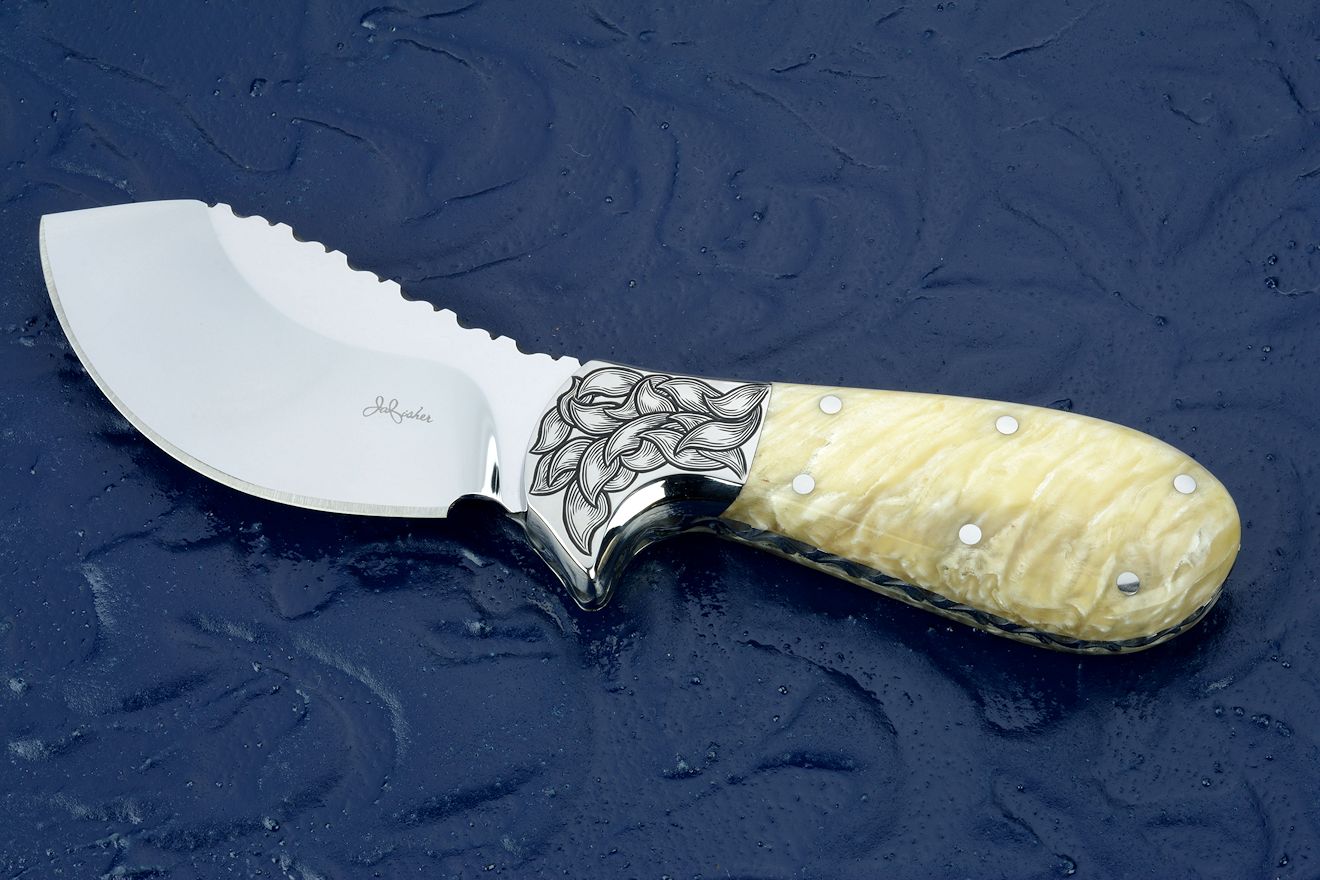
More nearly this Nunavut Skinner
History
The history is rich. From the offset time prehistoric human laced a bone handle to a piece of flint with some sinew, he realized the importance in this handle textile. Bones, tusks, and antlers from living animals memorialized the hunt, maybe personalized and all-powerful his knife with the spoils of his hunting efforts. At that place are practiced examples of carving ivory from as early every bit ancient Babylonia, 2300 B.C. The tradition of using animal parts for his handles connected throughout history, and continues today.
Return to Topics
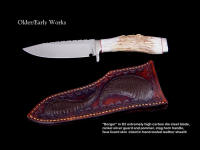
Berger
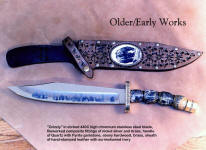
Grizzly
Advantages
Tradition, beauty, texture, and value.
Usually, the option to employ horn, bone, or ivory is i of tradition. Most of united states of america grew up conveying jigged os handled pocket knives, and in my mean solar day, we even carried our knives to schoolhouse. Every male child had his own pocketknife, and occasionally nosotros would find i that had been dropped, or lost, laying in the clay around the playground equipment. Nosotros would frequently play what nosotros called "chicken," where we would throw the knife between the anxiety of our opponent in turns, and movement our feet to the landing indicate of the bract, ever closer, until either one of our feet got stuck with the indicate of the knife, or nosotros chickened out. Normally, our knives were and then boring, they wouldn't penetrate a sail tennis shoe. Man, things have inverse today! Well-nigh of us are familiar with a stag handled hunting knife. This is the knife mode our fathers and our grandfathers grew up with. You didn't take a wooden handled butcher's knife on a chase, yous took a stag handled knife. Over again, this probably hearkens back to prehistoric principles of the hunt.
The choice to utilise horn, bone, shell, or ivory is as well one of beauty. Zilch looks like a piece of stag, furrowed and crude. Fresh elephant ivory is a beautiful solid flossy color, suitable for engraving, etching, or scrimshaw. Mammoth ivory can have stunning patterns in rich browns, reds, and even blues. The shapes of many antlers and horns left in the circular lend themselves to handles, the forms compliment knives and sometimes modern stands and fittings. Shells tin have stunning iridescent light play and a smooth lustrous finish.
The texture of many of these materials helps improve grip strength. Many horns, basic, and ivories become sticky when wet, thus improving grip security when working. The texture adds visual interest and contrast to a smoothen and polished blade. The texture of a fine organic material makes a transition betwixt the cold, inorganic steel blade to the living, warm, moving hand. The polished texture of ivory has a smooth comfortable feel, jigged bone is bonny and secure in the hand.
Value is ane of the more than modern reasons to utilize this textile. Ivories are hard to come by, ancient ivories are a limited resource. Mammoth and mastodon ivory, fossil walrus tusk, and fossil Oosic are some of the most valuable and sought subsequently pocketknife handle materials. Some shells, coral, and pearl families are rare and expensive. Many of these materials increment the value of the knife dramatically.
Render to Topics
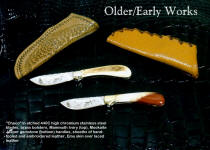
Chaco
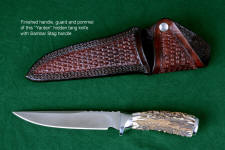
Yarden
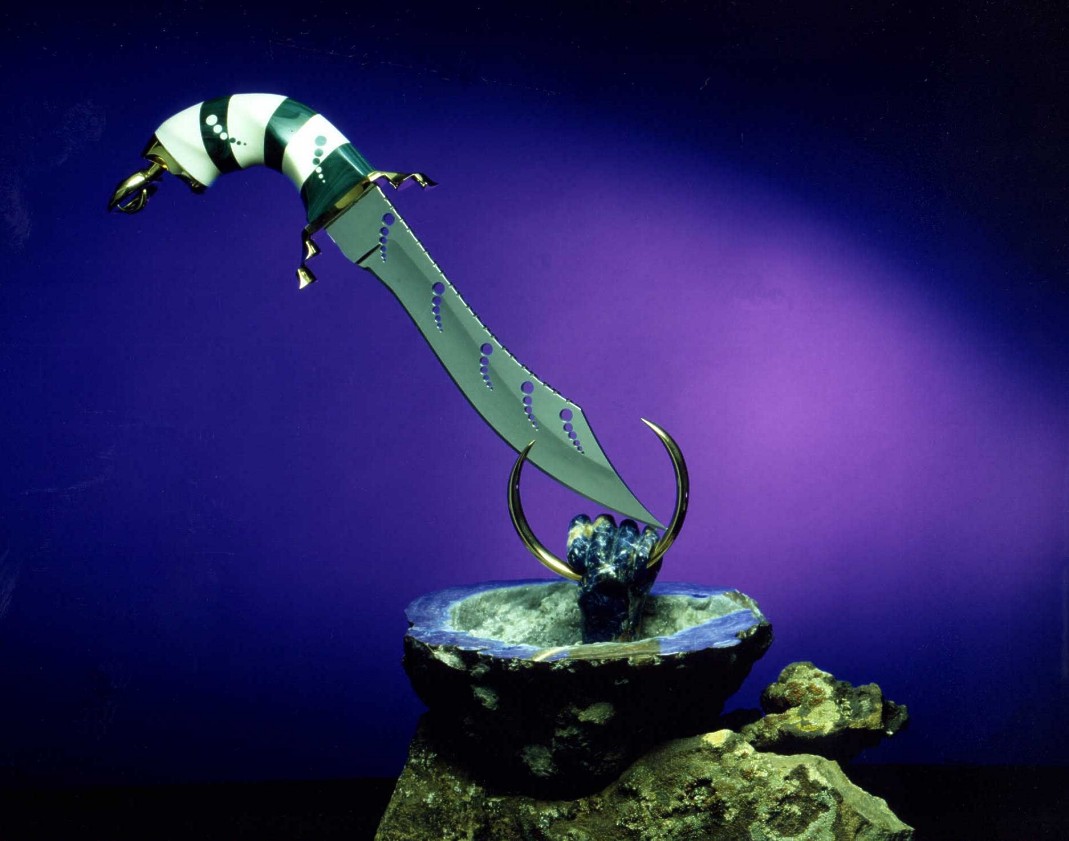
Disadvantages/Limitations
The outset problem with them is that all the materials listed on this folio are somewhat porous, and this effects stability. There are lesser and greater degrees of porosity, and that helps with good choices for handle applications. Beingness porous and organic, these materials absorb moisture, loose moisture, absorb contaminants, salts, and soil. Actress intendance must exist taken to keep the handle material make clean and dry out. Sudden changes in relative humidity (like moving from a damp forested environment to a dry air conditioned room) tin cause such a variation in moisture content that the textile shrinks and cracks away from bolsters, guards, or pins within hours.
Temperature also affects these materials radically. Putting a os or ivory handled pocketknife in the directly lord's day or under a bright display lamp for a couple hours tin can ruin it. Office of the problem is moisture content, simply another cistron is the coefficient of thermal expansion. Since the coefficient is much different than steel, move tin can be outright extreme. Often, pins and epoxy do non prevent movement, and eventually the bone, horn, or ivory shrinks, checks, and cracks away from the pins, bolsters and tang. This does non necessarily mean the terminate of the knife. As long as the knife is kept reasonably dry, information technology should last in service.
Lite can be another enemy. Many of these organic materials react to the long term exposure of light, sometimes bleaching and condign flat in color and depth. Since they are usually laying on one side, the other side will not bleach, and and so the knife looks like a different handle fabric was put on each side. On a subconscious tang pocketknife it can look every bit if information technology's been laying in the desert for a century. And the intensity of the light as well adds to the effects of drying detailed above.
Sometimes, checking in ivory is an advantage. It testifies to the age of the knife handle, and elephant ivory is graceful and forgiving in its yellowing and checking. It'south proof that it is indeed ivory, because replacements (like Micarta® and phenolic plastics) never change, age, or bank check.
Another disadvantage is toughness and hardness. Organic materials like horn, crush, bone, and ivory tin can hands be scratched, dented, scarred, and stained. Though some are tougher than others, they are not physically strong materials. Some are brittle, some are downright frail so special care must exist used in mounting them on the handle, and the knife and handle itself must be cared for with extra consideration.
Size and shape can be another limiting factor in knife handle pattern. Near of these materials are derived from curved pieces, and the geometry of the knife handle must incorporated these curves to exhibit the about from the handle material. Particularly, this can limit the width of the handle. Sections must sometimes exist made sparse to take advantage of the brandish surface area of the material, and this farther threatens overall force. That is why so many mammoth ivory handles, for example, are used on smaller or folding knives. The curve of the tusk tin not be fully applied to the handle flats if the handle is wide and large.
Legality: Some horns, bones, and ivory are banned! This takes some research, and you don't want some local or uneducated police enforcement person showing up at your home to confiscate your knife. This is becoming a serious issue, so it's best to avoid all organics that are restricted, similar fresh ivory, rhinoceros, walrus, tiger, or any other organics you are not admittedly sure are legal!
Render to Topics
Hullo Jay
I acquired 2 black rhinoceros horns in 1982 pre import ban and would similar to no if you lot have an interest, and or if I commissioned you lot to build me a series of knifes and employ them for the handles.
J.
Seriously, all rhinoceros species are critically endangered, and there are less than 5000 blackness rhinos left in the world today (at the time of this writing). I realize that yous have former rhinoceros horns, only do you have absolute proof of their origin? I'1000 certain you don't, for a slip of paper does not physically date organic horn, and that's your kickoff legal hurdle.
The showtime international ban on rhino horn trade was in 1975, and even today there are continual efforts to strengthen management of rhino horn trophies and implements, which means lots of legal authorities confiscating, and fining, and imprisoning. Like walrus tusk and recent elephant tusk, it's only non reasonable to make knife handles nowadays out of them without a lot of headache. I don't want to be called to prove in your behalf most the origin of a knife handle I made.
There are much more durable and beautiful handle materials! Have you actually seen rhino horn finished? It'due south compressed hair (keratin) and rather irksome and and not particularly distinctive or beautiful, and you really tin can't tell it from a water buffalo horn. The interest then is the romantic idea of the rhino horn, and not the beauty or immovability of the substance. In my earth, ideas tin be inspiration, but the magic is in the process and execution, not the suggestion that you wrestled a 3000 pound animate being to the ground to snap off his only protection from lions or other rhinos.
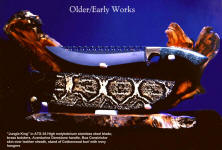
Jungle King
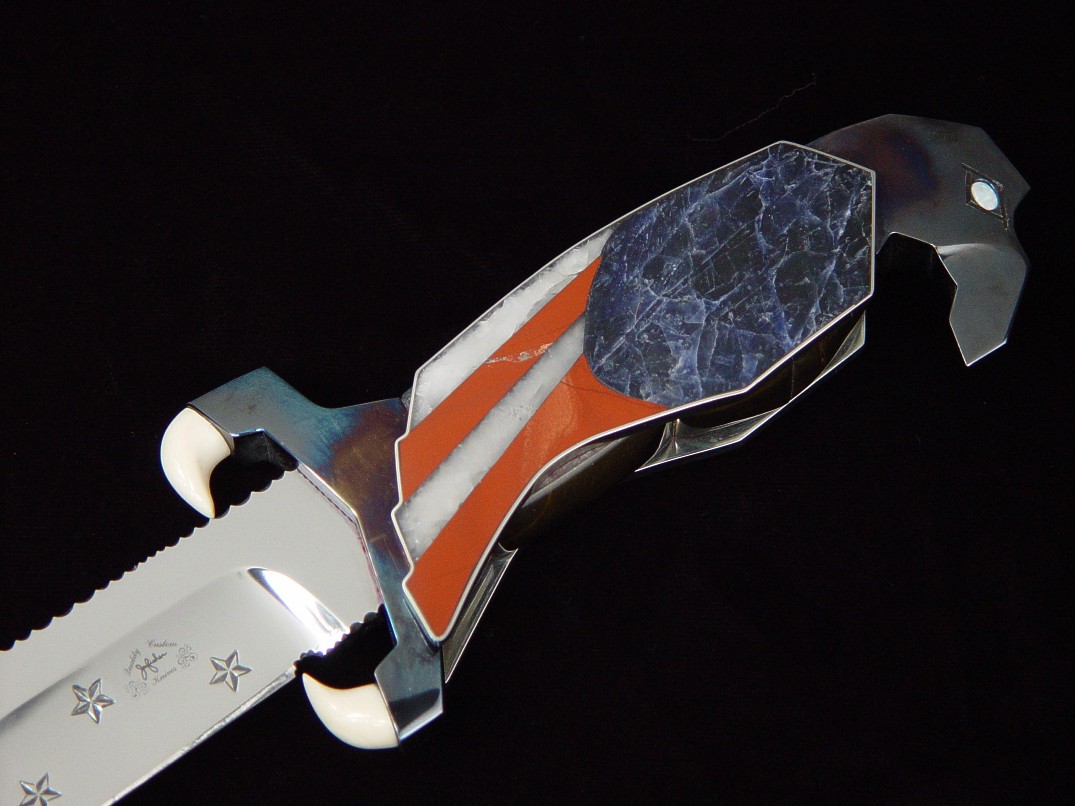
Other Uses
Knife handles aren't the but use of horn, os, and ivory. I often incorporate these materials into my display stands, sheaths, and even equally accent components in the knives themselves. Goose egg looks as rich and organic as ivory, polished horn, trounce, or coral. It is quite common to see a fork of an antler used to support or elevate a knife on a display stand, and though that is where almost of us showtime in our quest to brandish a knife, an development of that process is inevitable in the finer works.
Return to Topics
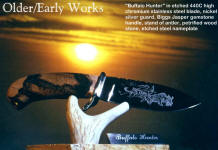
Buffalo Hunter
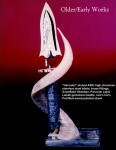
Hercules
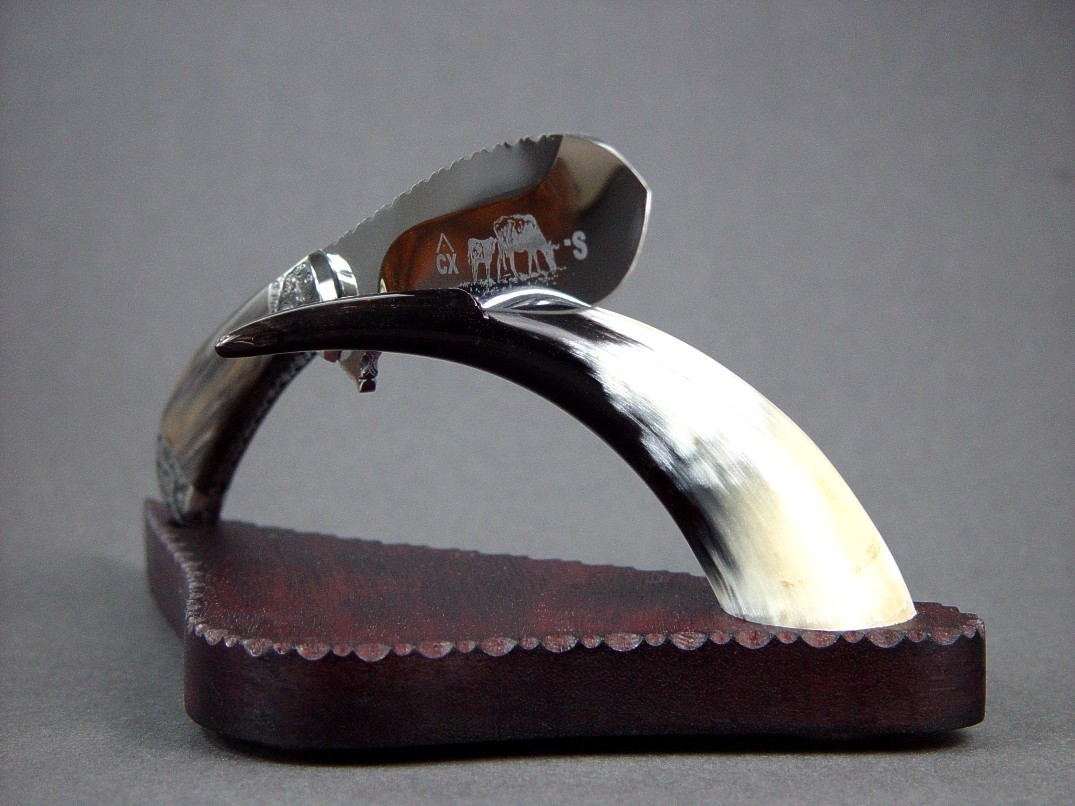
Horns and Antlers
Horns and antlers take been commonly used in knife handle construction for many millennia. Along with wood, horns and antlers are probably the oldest knife handle material. Horn and antler can be left rough, polished, or carved, sometimes scrimshawed or textured. Though they are similar and often referred to in the same reference, at that place are some of import differences.
Horn is generally a derivation of hair, actually hollow sheaths of keratin, tightly condensed and packed in a solid growth. Horns, such as cow horn and buffalo horn, are not shed annually, and commonly last the life of the animal. Horns are normally more dense than antlers.
Antlers are a porous bony bagginess that are shed annually, so antlers are a renewable resource. Elk, mule deer and white tailed deer are skillful examples. These sheds can be a valuable find in the forests of our land, and many hikers go out in the early on jump but to gather shed antlers. Antlers are usually more porous than horn. Some antlers are amend than others.
Often, the terms horn and antler and stag are interchanged, which can crusade some confusion. Each one deserves some special attention:
- Deer Antler (also chosen stag horn, deer horn): In America, this comes from the annual sheds of both the Mule Deer and the Whitetail Deer. While information technology can be fabricated into a serviceable knife handle, both these types of antler are rather porous, with a adequately tough outer beat out. They are probably the least expensive of handle materials on this folio. Availability is good, article of clothing characteristics are poor to fair. Appearance is off-white, contaminate staining is frequent. The best utilise of deer antler is past careful pick of thick, heavy portions that are on the surface of the antler. The only permanent method of construction and employ for a fine custom knife is to have the antler professionally stabilized. Run across stabilized horn below. Polishes well.
- Elk Antler (also called Elk horn) Comes from the almanac sheds of the American Elk, a large deer species in America. Elk antlers are definitely a step up from deer antlers, equally they are thicker, stronger, with a smaller central portion of porous material, and a thicker outer density. Availability is good, clothing characteristics are off-white to adept. Appearance is fair, contaminate staining is frequent. Every bit with deer antler, the best use is by careful option of thick, heavy portions that are on the surface of the antler. The merely permanent method of structure and apply for a fine custom knife is to have the antler professionally stabilized. See stabilized horn beneath. Polishes well.
- Sambar Stag Antler (likewise called Stag, India Stag, Stag, Axis Stag, Red Stag, Cutting Stag, Midnight Stag): Comes from the Sambar deer or Cheetal deer of India and the Pacific rim countries. There was an embargo on Indian Sambar that was lifted once and then reapplied, just the horn is available through other countries, and supplies can be found all over the web, so don't call up information technology is in any way rare. Sambar stag is one of the mainstays of organic handle fabric in fine custom knives. Different deer and elk antler, it is hard, tough, solid and dumbo. Instead of a large porous central core, it has a small core, and a very solid outer shell, extending through virtually of the antler. Information technology can have a beautiful brown textured surface, making information technology very attractive for pocketknife handles, and a secure, comfortable gripping surface. Polishes well, resists most stains, good wearable characteristics. Information technology's more expensive than deer or elk antler, simply well worth the expense. If you're set on having a traditional horn or antler handle, this is the material I recommend.
- Antler Scales vs. Crowns (all deer, stag, and elk): There are two arrangements to antler or stag horn application on a pocketknife handle. Scales are flat pieces slabbed from wide horns and applied to the flat sides of a full tang or folding knife handle. They are usually secured with bolster dovetails and pins. Crowns are the thick, wide flaring parts of the antler where it attaches to the animal's head. The crowns are ordinarily used on hidden tang knives, where the tang is inserted into a hole drilled in the core of the antler and secured with pins, epoxy, or hidden methods. This creates a handle that appears equally a solid piece of antler flaring out to the crown at the butt. The base of operations of the crown is a good area for carving, engraving initials, inlaying monogram plates, gemstone, or other artwork. Antler crowns are as well carved into belt buckles, conchos, or other jewelry or adornment and fittings. The most permanent method of structure and use for a fine custom knife is to accept the antler professionally stabilized, unless it's Sambar Stag which is fairly tough and resilient. See stabilized horn below.
- Caribou horn: Thicker sections and a lighter colour can make this an interesting handle choice. Same stability every bit antlers above.
- Stag, horn, or antler treatments: There are ways to care for the antler before and subsequently information technology is put on a pocketknife that change the clothing characteristics, the look, and the immovability. One fashion is flame handling, which burns the surface to a darker color, and hardens it somewhat. Stag tin can also be colored by stains or potassium permanganate baths. Another process is impregnation with hardening agents such as polymers, epoxies, cyanoacrilates, or sodium silicate. Probably the ultimate is pressure stabilization, done by several companies across this country, where liquid phenolics are forced under great pressures into the porosity of the material to fill any voids and substantially waterproof the cloth. The aforementioned process is used on hardwoods (see my wood pocketknife handle folio here). This is usually cost prohibitive on stag though, as stag is not considered as vulnerable or worthy of the handling. I've used about all the treatments listed above to some degree.
- Sheep Horn and Kudu (includes Merino Sheep or Dahl Sheep, Ram's Horn): Sheep horn is simply as tough equally Sambar stag, just with some heavy textural lines, and makes an interesting knife handle. Dark olive dark-green to brown, with some translucency. Availability is good, horn instability is the same every bit other horn materials. It is ofttimes cutting and steam flattened for use, which leads to questions about stability from moisture infiltration. Kudu horn is like in shape and end, both may be pressure stabilized and sealed.
- Springbok, Impala, Gazelle, and Oryx (Gemsbok) horn: These are like. Though they differ in shape, they take heavy ridges or texture along their length so that may in grip security when mounted on a pocketknife handle. Their stability is the same as any antler, and they are commonly bachelor.
- Cape Buffalo Horn, Ox Horn: Another mutual horn used in knife handles. Very dense and fairly hard, information technology is much better than typical antlers. Unremarkably black, but sometimes with white banding and other muted colors. Takes a glassy polish, some fifty-fifty looks like polished plastic.
- Cow Horn: Though sometimes used on custom knife handles, I've simply used it on stands. Variegated colors, white, gray, brown, black, olive. Polishes well.
- Stabilized horn: Most of the horns and antlers listed on this page tin exist stabilized, that is impregnated with dyes and resinous or phenolic liquid plastics (polymers or phenolics) at high pressures, essentially making a cake of plasticized horn textile. Though this is washed some, I think it holds a huge opportunity to stabilizing firms in the future. The materials become impervious to impregnation by liquids, they become waterproof, dimensional stability is increased, and performance is greatly improved. I suppose that the expense of stabilization is besides loftier, and low-end knives are better suited to the use of non-stabilized horn and antler material. I exercise have some stabilized horn, though, and it works very well.
Return to Topics
Ivories and Tusks
Ivories are animal teeth. Ivories and tusks are unusually dense, some of the densest, hardest animal parts and remains. They are much less porous than bone, therefore last longer, are less apt to absorb liquids, and smooth better. They are definitely a step up from os and antler, merely cost considerably more than. Even so, they are not impervious to wet damage, expansion and contraction, staining, and separation from the knife handle.
I read an advertizing copy on i web site and the claim is when you buy a custom carved ivory knife handle, "yous will own an exclusive piece of work of art that will defy time." What? Ivory shrinks, dries, checks, cracks, stains, and yellows. Time is an enemy of ivory, it volition not defy time in any sense of the discussion. Such claims like this do our business and tradecraft a huge injustice. What handle material volition defy time and even outlast the blade? Why, gemstone, of course.
Ivories have traditionally been the most favored of animal parts for pocketknife handles, jewelry, and accessories, so much so that the trade in ivory has reduced some animal species to near extinction. In that location is a lot of regulation and restrictions on ivory utilise, and documentation of the origin of certain ivories can exist tiresome, only for the supplier and maker, not usually for the knife customer or collector. Overzealous bureaucrats have even confiscated Mammoth ivory handled knives assertive the ivory was from contempo elephants. Maybe they were trying to protect the Mammoths from extinction... oops, too late.
Here are the types with details:
- Elephant Ivory: Elephant ivory (tusk) is a traditional fine pocketknife handle material. It is what the full general public is usually referring to when they use the singular term ivory. It is non as popular every bit it was 20 years ago, because of restrictions, regulations, and public sentiment over threatened elephant herds and populations. Since no elephant ivory is allowed to exist shipped into or out of the U.s., and there is a new, near total ban on elephant ivory utilize in the Us, ane can only assume that the ivory is legal, from existing stock already in the land but information technology must be accompanied by all-encompassing documentation and provenance. More on the new ban below. Ivory is dense, solid, low-cal creamy white when freshly cut and polished, and yellowing and checking (small cracks at final ends) with historic period. All age-related changes in ivory are considered a natural office of the fabric, and even valued as a testament to the actuality and age of the ivory. Former ivory has a warm, appealing patina, and the grain in the material becomes more apparent with age, thus identifying the ivory every bit real, and not a plastic faux. Elephant ivory tin be brightly polished, and retains a vivid luster, and tin can be easily scrimshawed with high detail that increases the value of the knife profoundly. I have, withal, seen some fine ivory ruined by bad scrimshaw. Elephant Ivory carves well, and can hold loftier detail. Ivory is non an extremely durable handle cloth, and must be cared for and protected with vigilance. Several hours in the bright hot sunlight or under quartz lamps can ruin an expensive pocketknife handle or carving. Some states prohibit all trade in ivory products, so conscientious inquiry of local regulations is required to preclude confiscation of your fine knife!
- Mammoth Tusk, Mastodon Tusk: Likewise chosen Aboriginal Ivory, this is 1 of the about popular custom and handmade knife handle materials. These are the actual tusks of Mammoths and Mastodons that have died thousands of years ago. Sometimes called "fossil ivory", this is a complete misnomer, since fossilization is the replacement of the ivory by stone. Fossils are solid minerals with no organic material whatsoever; they are rocks. Mammoth ivories may well be thousands of years quondam, but fossils are millions of years onetime.
These tusks come up from areas where these extinct beasts accept died, and their tusks accept been buried before long enough to forestall consumption by other animals, and are thus preserved in soil, muck, or debris. The soils so impart color into the old ivory by thousands of years of h2o conveying traces of minerals into the organic ivory, staining it. The highly stained surfaces are the most valued, with browns, blackness, dejection, rusts, and greens in the ivory. Also, some interesting staining patterns tin can develop. The minerals harden and stabilize the ivory to unlike degrees, and that probably has to do with their age and surroundings later burying. And then these ivories are more durable than contemporary elephant ivory, just tin can be brittle. Each piece is different. They commonly take a high, glossy polish, and are highly valued, increasing the worth of a custom knife tremendously. Information technology is not uncommon to pay hundreds of dollars for the mammoth ivory scales before ever mounting them on a knife. The best mammoth ivory material is stabilized (encounter topic to a higher place). - Walrus Tusk: Current walrus tusk can only exist caused by registered Native Americans, and owned by them only, at least that is the current law. I accept worked with information technology before for Native Americans, and I can say it'southward harder and tougher than elephant ivory, more than durable and less brittle, and very white, taking a glassy smooth. There may be electric current suppliers of walrus tusk, only trying to bend current regulations is not worth a legal battle or a reputation. Some laws vary, and I'k certain that imports are tightly controlled and restricted, then it depends on your state and country.
- Fossil Walrus Tusk: Just like the term "Fossil Mammoth Ivory" above, this is a misnomer. Truly fossilized walrus tusk would be stone, the original tusk replaced by minerals. Just the term is used to describe old or ancient walrus tusk. This is much like mammoth and mastodon ivory above in color, admission, and origin. It does seem tougher than the electric current tusks, and has some interesting mottled patterns in the eye. Be careful here, because some law enforcement types mistake ancient walrus tusk for current walrus tusk and will attempt to confiscate it, not knowing the difference.
- Wart Hog Tusk: Easily obtainable, this curved, squarish, tooth is only about the correct size for a hidden tang handle. It polishes brightly, is very hard and dense, and ivory or white colored. It scrims well, and is fairly durable.
- Hippopotamus Tusk: Hippo tusks are a great replacement for elephant ivory, and are in fact ivory just as elephant tusks are and every bit wart grunter tusk is. They're hard, dense, and take a bright polish. They are reasonable in price and availability. The same limitations and concerns with moisture and temperature changes likewise as stability are present.
- Elk Ivory: Elk, unlike other deer, have stubby rounded canine teeth in the upper function of their jaw. They are probably remnants of a time when they used canines for fighting. In North America, they are the simply real available ivory. Out west, we phone call them "whistlers" believed to help the elk trumpet or bugle in his telephone call. Some Native American tribes believe they possess magical backdrop. They are small ivory teeth used by jewelers and sometimes used as accessories in knife handles or sheath decorative ornaments. They smooth, carve and scrimshaw well.
- Whale'due south Tooth: This is the tooth of the sperm whale, a highly prized, very expensive and rare detail sometimes actualization on pocketknife handles. Since the sperm whale is endangered and protected, and any importation of parts has been prohibited since 1973, all whale's teeth must be predated. Old (antique) whale's teeth can be found, but it would exist ridiculous to put this valuable particular on a knife handle, as information technology would have to be cutting, shaped, and finished, ruining its antique value. At that place actually is no reason to promote the use of whale's teeth on custom pocketknife handles, equally there are much more suitable, available, and appropriate ivories.
Return to Topics
New Ban on Elephant Ivory in the United States
Elephant ivory in knives is at present finished.
Equally of July six, 2016, new elephant ivory-containing items are banned from sale in the United States, and older stock with elephant ivory is severely restricted. The Department of the Interior's Usa Fish and Wild fauna Service has extensive details on their website, merely it's articulate that this is an effective ban on elephant ivory sales. Clearly, elephant ivory in knives, knife handles, sheaths, components, and accessories is finished in the United States.
How this looks for knife makers and collectors and owners of knives is not skilful, if they prefer ivory, horn, bone, or natural organic materials. No new knives with ivory tin be fabricated and sold. All ivory that is not aboriginal must be accompanied past extensive paperwork and documentation, or the risk of confiscation is assumed. All other ivories will be subject area to scrutiny; all-encompassing laboratory examination must exist made to distinguish elephant ivory from mammoth or mastodon tusk, or mod wart hog tusk, hippopotamus tooth, or other materials similar in advent. The topic tin can exist summed in this interview and questionnaire I gave to Michael Haskew of Blade Magazine on August 23, 2016. His questions and my consummate answers follow:
Numbered questions by Mr. Haskew, of Blade Magazine (August 23, 2016)
i. Tell me well-nigh your visitor. What exercise you do exactly? How long take you lot been in business concern
I am and take been a full fourth dimension professional person knifemaker for 28 years and have been making custom and artistic knives for combat professionals, knife users, and collectors. I've been making knives for 38 years.
2. What does the Fish and Ivory Wildlife Rule that went into outcome July half-dozen mean for you and your concern?
It'southward important to understand that this is a near total ban on elephant ivory sales. Clearly, elephant ivory in knives is finished. I won't be using whatsoever elephant ivory, and mammoth ivory I employ volition be very limited to but very dark, stained, and evidently ancient ivory.
3. Are you restricted in where you can sell ivory now?
Not sure of this question; since information technology is now August, and all current elephant ivory sales are restricted or banned, according to the de minimis exception, listed on the U.S. Fish and Wildlife International Affairs website detailing the new laws. Elephant ivory without detailed provenance is now illegal to sell. All new elephant ivory paw crafted items are now illegal to sell.
four. Practise y'all know of whatever recent raids or confiscations that take taken identify? Could yous tell me most the evens surrounding them?
No.
v. Are yous cut dorsum on stocks of ivory and concentrating on other materials instead? If and then, what other materials and why?
Unfortunately, this ban and severe restriction of ivory sales does not just affect elephant ivory. I haven't made or sold a knife with elephant ivory in many, many years, but there are many types of ivory that resemble elephant ivory. These are not banned, but are fish and wildlife officials and law enforcement agents going to be conveying around long-wave ultraviolet lamps to determine mineral inclusions of ancient ivory, along with a testing standards kit, and a 10-power magnifier to determine if mammoth ivory is not elephant ivory? Oh, and don't forget, they demand to bear along a photocopy motorcar, with variable contrast and a ruler and protractor to measure Schreger lines for this conclusion. Since this is unlikely, venues, dealers, and websites may ban all ivory types, whether wart hog tusk, mammoth ivory, or hippopotamus tooth, since determinations may be hard and costly.
6. What tin knife collectors wait to run across in the fashion of handle materials in the hereafter?
Considering of the ban, non-elephant ivory and ivory-like items may be less desirable. Collectors and knife owners simply don't want the hassle of the threat of confiscation, or having to possess all-encompassing documentation and provenance to prove their handles are legal. In tactical and working knives, manmade materials and plastics will dominate, but exotic woods may be next on the horizon of command and restriction. In my own art and profession, gemstone has been a mainstay for decades, and I believe it will keep to exist the premium material for knife handles in the future. It's strong, extremely stable, and strikingly cute. No living species, found or animal, will exist directly endangered by its use, and in most cases, it will outlast the knife itself.
7. How difficult is information technology to prove that your ivory inventory was bought earlier a sure yr? What year is the cutoff at present? In general, how difficult is it for anyone to discover the necessary information?
It's fairly easy to detect the information about the ban on the The states Fish and Wildlife's website. The information is non proficient for owners of any elephant ivory.
- Almost knife sales in the Usa are interstate.
- The elephant ivory-handled knife must qualify for the de minimis exemption to exist legally sold.
- The de minimis exemption requires detailed provenance and documentation accompanying the ivory. No affair when the ivory was purchased, the documentation must accompany it in every circumstance of exchange or auction, and for the life of the finished product.
- All of the other requirements of the de minimis exemption are usually not applicable to knives: the ivory in a handle comprises less than one-half the value, information technology is less than half the volume, the ivory weight is normally less than half of the 200 gram limit, and information technology is not raw.
- A huge outcome is that no detail manufactured after July half-dozen, 2022 meets the de minimis exception, so new elephant ivory-handled knives merely are illegal to sell. Elephant ivory in knife handles is done.
eight. What kind of advice would you offer to knifemakers and knife buyers in terms of the new rule when it comes to the ivories they accept on mitt in either unattached scales or ivory knives in full general?
Unfortunately, because of the final rule in the de minimis exception, elephant ivory currently not mounted on a finished knife made before July 6, 2016 cannot legally be used to put on a knife and sold. It'south pretty clear. Then elephant ivory scales are now valueless. Even if a knife with elephant ivory or merely the elephant ivory is given away, it needs to accept accompanying documentation. If a knife was made before July 6, 2016, it must accept all of the documentation and provenance accompanying it to exist sold. Likewise, don't be surprised if the knifemaker is asked to evidence when the knife was fabricated to satisfy this rule, which is very hard to establish and defend in a legal setting.
What should collectors buy and not buy due to the new rule? What should knifemakers buy and non purchase?
It's probably not wise to saddle a knife client and owner with the hassle of extensive paperwork, proof of origin, and dated provenance to continually evidence his ivory was of legal origin.
Collectors and makers both demand to stay away from elephant ivory. The ground of the law has skilful intentions, to cease the slaughter of elephants and prevent diminishing herds. There are much more stable, mutual, and accessible knife handle materials. It's not worth criminal or ceremonious penalties and jail time.
9. Any other comments you might take would be greatly appreciated
Ivory is now finished in knife handles in the US, as this is a near total ban. No new elephant ivory-handled knives can be legally made and sold. Consider this shocking fact: even though ivory in handmade products is banned, United States hunters are immune to bring up to iv "trophy" tusks per person, per year into the United states. How does this assist the dwindling elephant herds? This is our regime at work.
Officials, law enforcement, and Game and Fish volition be confused by the many ivory types available, including wart grunter tusk, hippopotamus ivory, mammoth, mastodon, and walrus. Adding to the defoliation are materials that look like ivory: trounce and bone, stag and brute horn and manmade materials like acrylic and Micarta®. All of these must be accurately and completely detailed and identified with accompanying documentation when necessary. If this direction continues, it wouldn't surprise me if exotic wood species bans are next.
Render to Topics
Bone
Brute bone has been used on knife handles since the dawn of fourth dimension. Whether to correspond the hunt and quest for game, or because information technology was a willing and workable raw textile, or perhaps because ancient man simply wondered what to do with all that extra bone lying around, it plant its way to the handle. Bone is easily worked, plentiful, and fairly durable. On the modern custom knife, though, it has some bug. Outset, information technology is very porous. That means that it absorbs pretty much anything it contacts. Perhaps in ancient times, the tissues and fluids and sweat it encountered would help information technology stabilize, while imparting a weather resisting patina. Nowadays, no ane field dresses their hamburger, or scrapes a hide to make boots for tromping through the snow after mammoth. And so the bone is left to dry out, absorb atmospheric wet and fluids from the hand, and is subject to continuous heating and cooling of the days and seasons. And so, beingness then porous, it expands and contracts extensively, and eventually works itself loose from fittings, cracks around pins, fights whatsoever method of attachment used to fix it to a pocketknife tang. Information technology is much more unstable than ivory, and is therefore usually used on the cheapest of knives. Bones mounted on pocketknife handles are often jigged. Jigging in this context is a word that comes from Scotland, and refers to any mechanical contrivance that operates by repeated jerky and reciprocating movement. So jigged bone is named for the jigging machine that cuts it. The cuts in the os give information technology some tactile purchase, especially when wet, offer some visual interest, and hide grainy porosity in the finished surface.
- Animal Bone is more porous than ivory. Bone has always been a staple on factory folding knives, and has fair clothing characteristics. It can exist jigged (cutting in a repeating pattern) to increase tactile friction and increase visual interest. Os takes dyes well, and can be stabilized. It is generally not considered a high value handle fabric. Many types of os may be used, commonly popular are including cow and giraffe os. The simply permanent method of construction and employ for a fine custom pocketknife is to take the os professionally stabilized. See stabilized horn higher up.
- Oosic: is the penile os of the walrus. The bone is very strong and frequently large, and is easily obtainable. It has an outer hard beat that is well-nigh as dumbo equally ivory, and takes a very fine smooth. The smaller stop of the Oosic creates a fine subconscious tang handle when left consummate. At that place is considerable superstition and mojo fastened to the Oosic, as you can imagine. Although Oosic is mutual, I've seen hyper inflated prices and "rarity" claimed. It can be carved, scrimshawed, and dyed. It fares better than stag, horn, and bone in longevity on the knife handle, just not as adept as ivory.
- Fossil Oosic: This is the penile bone of the walrus that has been cached for a long period of fourth dimension and is mineralized, merely it is not a true fossil, since true fossils are stone. Similar to the mammoth or mastodon ivory above, the mineralization can vary. Ancient Oosic is more stable than recent Oosic, has darker and interesting colors, and is more expensive. It'southward also harder to work and can exist a flake more brittle.
Return to Topics
Pearl, Shell, Coral
The bounding main has offered us some beautiful materials for knife handles and adornment. These organics can include fish teeth and bones, but their use in knife handles is rare. Pearl, shells, and coral are abundant and moderately durable once mounted on the knife.
- Mother of Pearl (MOP) is a mutual handle material for fine knives, guns, and inlays and has been used in artwork for thousands of years. Also called nacre, it is the internal shell layer of select mollusks (yeah, it'south a seashell). It's chosen for its silky iridescence, and moderate toughness, but it is brittle on knife handles and must be worked and mounted with conscientious consideration. It's long lasting and beautiful, though in some applications can be a bit gaudy. It can be tinted about whatever color, and at that place are several choices that are ordinarily used and accepted in knife handles. Information technology is moderately expensive in large or thick sections, and has medium wear characteristics. In some designs information technology might seem cold, not warm or substantial similar ivories and hardwood. Pinning MOP is a delicate process, and heat should exist avoided. Once the MOP is mounted it is more durable, but is not a good application for heavy employ knives or knives that may suffer bear upon.
- Abalone Shell is a source of mother of pearl. This large, edible sea snail has a highly iridescent and colorful vanquish, and has been used as ornament by many cultures. Paua beat out is abalone shell; the give-and-take is the Maori give-and-take for abalone. There are over 100 species of abalone, including a host of human being-created hybrids. Though there are supposed to be restrictions and controls on harvesting the abalone, sources of abalone (or Paua) are all over the cyberspace. Related abalones that are harvested worldwide are: Perlemoen (Southward Africa), Ormers (Channel Islands), and numerous countries who now grow and farm abalone. Though the "rarity" is played upward past abalone sellers, a simple net search volition yield thousands of sources for this shell. Since the abalone is a scrap minor for knife handles and thick cantankerous sections are not common, it'southward used a lot in inlays, mosaics and areas where smaller pieces can be applied.
- Gold Lip Mother of Pearl is an oyster beat, and has a rich, nighttime yellow-gold colour, sometimes with olive edges or streaks. Its characteristics are the same every bit female parent of pearl and other shells, and the only real difference is the color. It sounds impressive, though when put on a pocketknife handle to have the give-and-take "gold" in the description. I wonder if it would be so popular if it were called "yellow-brownish seashell... "
- Tiger Coral is an interesting coral textile, due to its tan and brownish scarlet stripes running through. Coral is not the best handle material, information technology is somewhat breakable and hard to mountain. Similar pearl, it must be well protected in the knife handle structure, to avoid chips and protect edges. Coral has been pop throughout history considering it is easy to work, brilliant, and somewhat exotic. Watch out for limestone imitations of Tiger coral, with stripes but painted on! Many corals are commonly dyed to produce the desired color.
Render to Topics
Cheers for being here!
I'll add new photographs and descriptions of my horn, bone, ivory, and shell handles, components, fixtures, fittings, and artwork as they become available.
Return to Topics
![]()
Copyright 1996-2022 by The Jay Fisher Company. All rights reserved. Federal copyright law prohibits unauthorized reproduction past any means and imposes fines upwards to $25,000 for each violation. Learn more.
Source: https://www.jayfisher.com/Handles_Knife_Horn_Bone_Ivory.htm
0 Response to "What Is Used in Art That Looks Like Bone"
Post a Comment